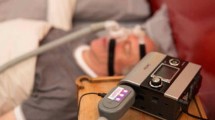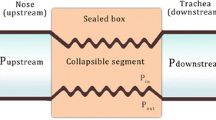Summary
Question of the study
Nasal continuous positive airway pressure (CPAP) prevents collapse of the upper airway during sleep in patients with obstructive sleep apnea provided that a positive transmural pressure can be maintained during inspiration. We examined pressure-flow characteristics in seven CPAP and bilevel devices during spontaneous breathing.
Methods
The CPAP devices were set to a pressure level of 9.8 hPa (10 cm H2O) and adapted to a pneumotachograph using a standard CPAP hose and an outlet valve. We continuously measured flow, volume and pressure during resting ventilation and increasing voluntary hyperventilation and analysed the dependence of the variables on a breath-to-breath basis.
Results
Mean CPAP pressures differed between the devices (9.9–10.6 hPa) despite the same settings. In all machines pressure fell during inspiration to 8.4–9.8 hPa and increased during expiration to 11.1–11.7 hPa. This effect increased with higher flow rates. Maximum expiratory pressures rose to 12–19 hPa at peak flow rates of 2 l/s, mean expiratory pressures to 9.5–16 hPa. Inspiratory pressures dropped to 8.5–4.5 hPa (minimum) and 10.5–6.0 (mean). Bilevel devices shoed a higher stability than CPAP devices. Pressure swings during the respiratory cycle increased the additional work of breathing.
Conclusions
Due to differences in mean and effective CPAP levels CPAP devices are not simply exchangeable but should be individually adapted. Patients with higher minute ventilation might benefit from more stable CPAP machines. The impact on patients' compliance remains to be evaluated.
Zusammenfassung
Fragestellung
Nasaler kontinuierlicher positiver Atemwegsdruck (CPAP) verhindert bei Patienten mit obstruktiver Schlafapnoe den Kollaps des oberen Atemwegs im Schlaf unter der Voraussetzung, dass während der Inspiration positive transmurale Drücke aufrecht erhalten werden können. Wir überprüften das Druck-Fluss-Verhalten von sieben verschiedenen CPAP-und Bilevel-Geräten während Spontanatmung.
Methodik
Die Geräte wurden auf einen Druck von 9,8 hPa (10 cm H2O) eingestellt und über einen Standard-CPAP-Schlauch und ein, Auslassventil an einen Pneumotachographen angeschlossen. Kontinuierlich wurden Fluss, Volumen und Druck zunächst während normaler Ruheatmung, dann unter zunehmender Hyperventilation gemessen. Ausgewertet wurden die genannten Parameter Atemzug für Atemzug.
Ergebnisse
Mittlere CPAP-Drücke variierten je nach Gerät zwischen 9,9 und 10,6 hPa trotz gleicher Einstellung. Bei allen Geräten fiel der mittlere inspiratorische Druck auf 8,4–9,8 hPa und stieg der mittlere exspiratorische Druck auf 11,1–11,7 hPa. Dieser Effekt verstärkte sich mit zunehmenden Flüssen. Maximale Drücke während der Ausatmung stiegen auf 12–19 hPa bei maximalen Flussraten von 2 l/s, mittlere exspiratorische Drücke lagen dabei zwischen 9,5 und 16 hPa: Inspiratorische Drücke fielen auf 8.5–4.5 hPa (Minimalwerte) und 10,5–6,0 hPa (Mitteldrücke). Bilevel-Geräte zeichneten sich durch eine höhere Druckstabilität aus. Die Druckschwankungen während des Atemzyklus erhöhen die zusätzliche Atemarbeit.
Schlussfolgerung
Aufgrund der unterschiedlichen mittleren und effektiven CPAP-Drücke halten wir die CPAP-Geräte nicht für einfach austauschbar, sondern sie sollten individuell an den Patienten angepasst sein. Patienten mit höherem Atemzeitvolumen könnten aufgrund niedrigerer Atemarbeit von stabileren Geräten profitieren. Der Einfluss der Druckstabilität auf die Patientencompliance bleibt zu untersuchen.
Similar content being viewed by others
References
Abbey NC, Cooper KR, Kwentus JA: Benefit of nasal CPAP in obstructive sleep apnea is due to positive pharyngeal pressure. Sleep 12: 420–422, 1989.
Chediak AD, Lipson E, Demirozu MC, Kiel M: The second generation of nasal continuous positive airway pressure devices-Are they created equal? Sleep 16: 662–667, 1993.
Demirozu MC, Chediak A, Nay K, Cohn MA: A comparison of nine nasal continuous positive airway pressure maschines in maintaining mask pressure during simulated inspiration. Sleep 14: 259–262, 1991.
Lofaso F, Heyer L, Leory A, Lorino H, Harf A, Isabey D: Do turbines with servo-controlled speed improve continuous positive airway pressure generation? Eur Resp 7: 2077–2081, 1994.
Pepin JL, Krieger J, Rodenstein D, Cornette A, Sforza E, Delguste P, Deschaux C, Grillier V, Levy F: Effective compliance during the first 3 months of continuous positive airway pressure. A European prospective study of 121 patients. Am J Respir Crit Care Med 160: 1124–1129, 1999.
Raschke F, Fischer J: Gerätevergleich für CPAP- und BiPAP-Geräte hinsichtlich Atemarbeit. Druck-und Flusskonstanz. Pneumologie 49: 205–208, 1995.
Schäfer T: CPAP-Gerätevergleich unter standardisierten Bedingungen. Somnologie 1: 85–89, 1997.
Schäfer T: Druck-und Triggerverhalten von. “BiLevel-Positive-Airway-Pressure”-Geräten. Somnologie 1: 90–95, 1997.
Sullivan CE, Berthon-Jones M, Issa FG, Eves L: Reversal of obstructive sleep apnea by continuous positive airway pressure applied through the nose. The Lancet 1: 862–865, 1981.
Viale JP, Annat G, Percival C, Bertrand O, Motin J: Added inspiratory work of breathing during CPAP ventilation: comparison of two demand-valve devices with a continuous flow-system. Interns Care Med 12: 374–377, 1986.
Author information
Authors and Affiliations
Rights and permissions
About this article
Cite this article
Schäfer, T., Vogelsang, H. Pressure stability of nasal CPAP and bilevel devices. Somnologie 6, 79–84 (2002). https://doi.org/10.1046/j.1439-054X.2002.02182.x
Issue Date:
DOI: https://doi.org/10.1046/j.1439-054X.2002.02182.x




